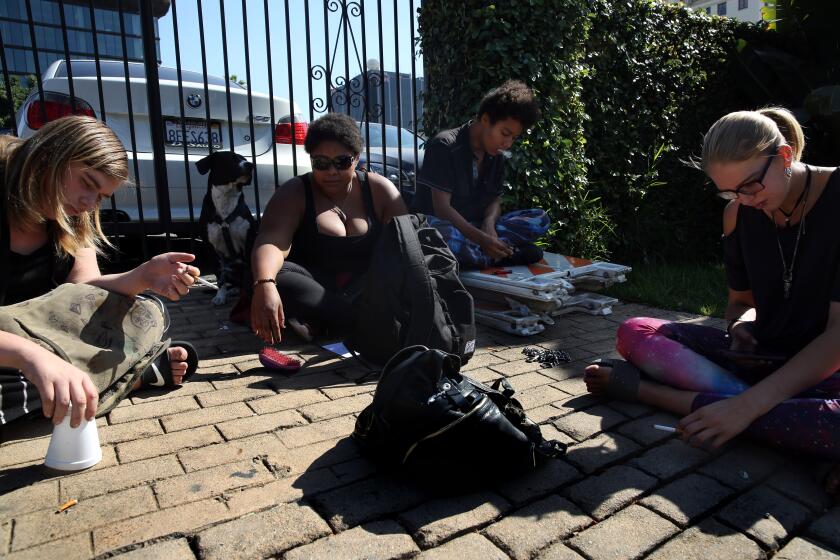Column: In the dysfunction of L.A. homeless policy, one cop tries to make a difference
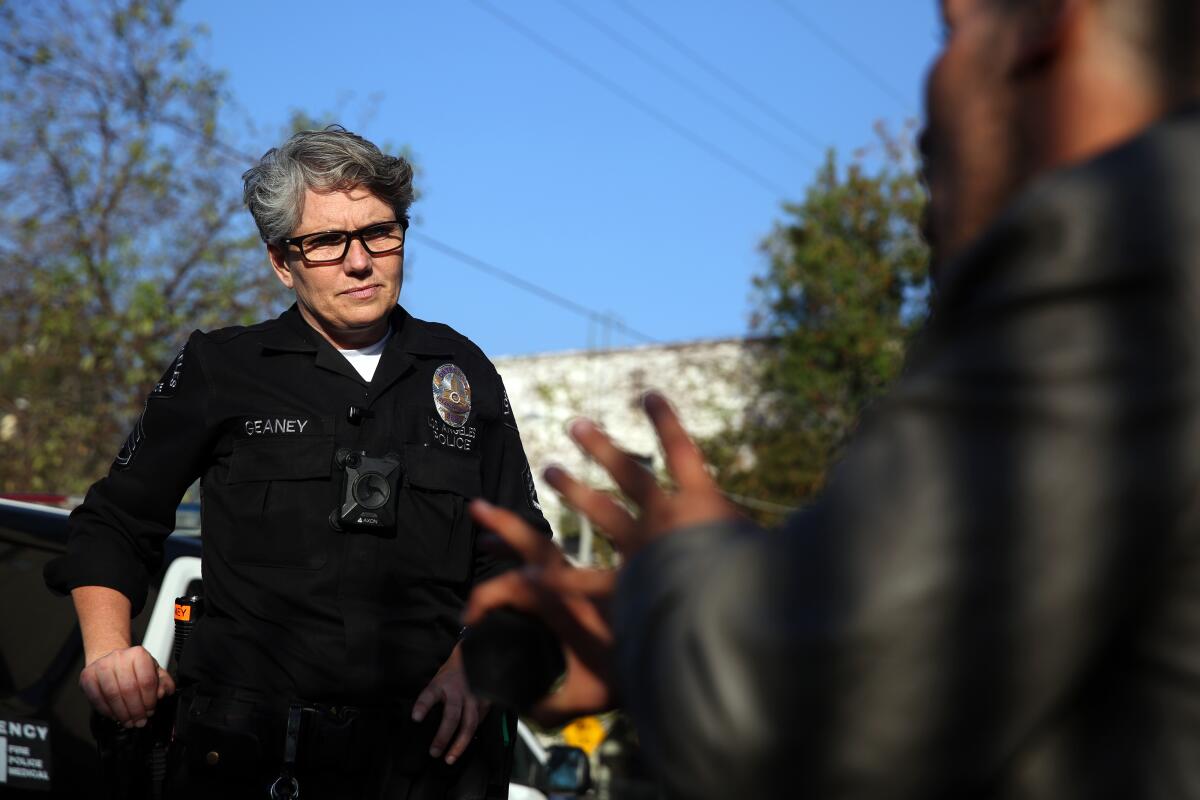
Part Three: The police
LAPD Det. Shannon Geaney reports daily to what looks like anarchy, bedlam, madness.
She works Hollywood, and her beat is homelessness.
On a recent morning, her first call of the day sent her to a small park near Selma Avenue Elementary School, where a man known as Papa Smurf had overdosed on opioids. A nurse from the nearby LGBT Center was summoned before Geaney, and she had administered two shots of naloxone, but Papa Smurf wasn’t responding.
Geaney handed the nurse a third dose of nasal spray, and it saved the man’s life.
On another morning in that same neighborhood, Geaney was on foot patrol, making sure an array of tents had been collapsed and sidewalks were cleared, as required by a city ordinance. One remained, and as a sanitation crew cleaned up around the campsite’s periphery, Geaney told the tent’s occupant she would have to clear out.
The woman did not respond.
Geaney repeated the demand.
No response.
Geaney told the sanitation crew chief to go ahead and clear the camp, the law is the law. But the worker said he couldn’t do so without approval from the Los Angeles Homeless Services Authority, and the agency rep had not shown up.
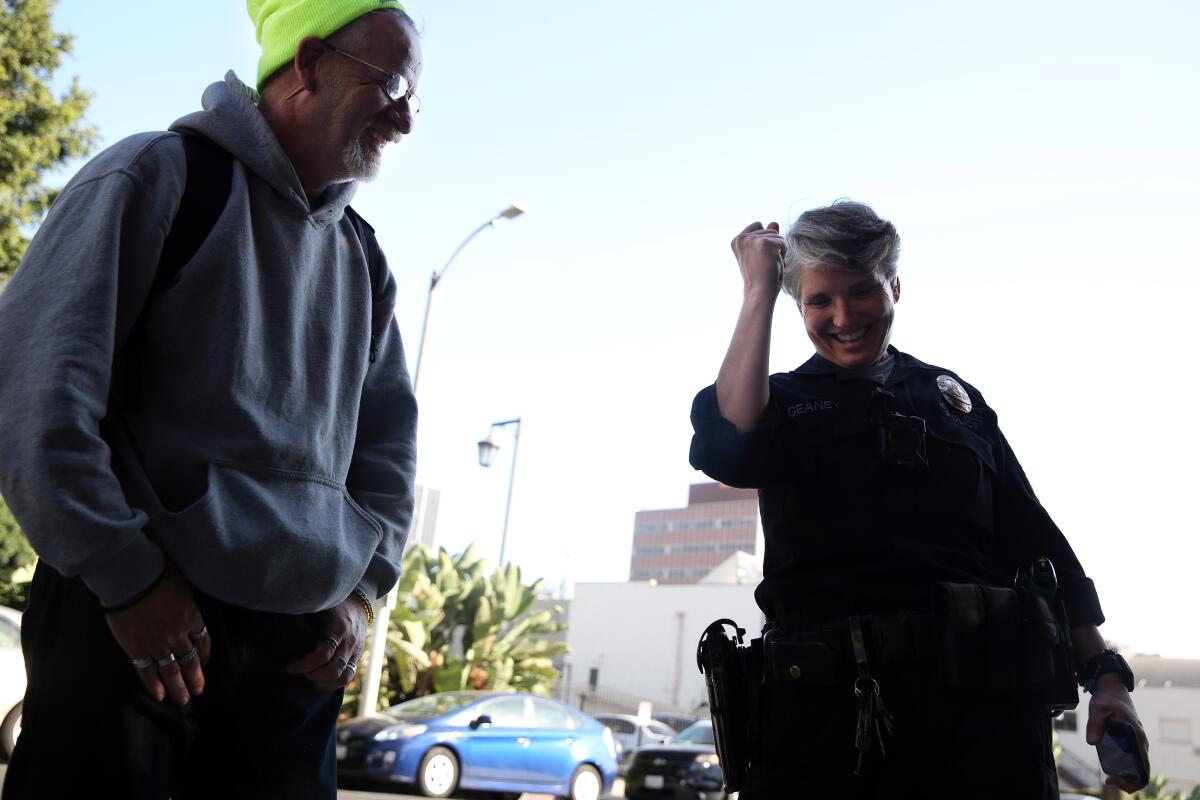
Geaney, who runs a team of eight officers focused on Hollywood homelessness, harrumphed and pulled out her phone. She had to make two phone calls, one of them to a deputy in Mayor Eric Garcetti’s homeless services unit, to get the authority to do what the law required. The woman finally began gathering her possessions and moving along.
“This is crazy,” said Geaney, and who could argue with that?
How many city departments does it take to remove a single tent in a city that has lost control of its homeless problem? Three in this case, plus LAHSA, a city-county agency.
The flowchart is big but the leadership board is small, and while there are no easy answers to the tangled social, political and economic drivers of homelessness, there has to be a better way than to stay the course, if, in fact, there is a course.

Geaney served for 11 years in the Marine Corps, where her missions included disaster relief in Jakarta after a deadly earthquake and in Southeast Asia after a killer tsunami. Now, she wonders why Los Angeles can’t treat its own disaster as effectively.
Why can’t we commandeer public buildings, she asked, provide housing and medical services and do whatever else it takes to help people begin to recover? Do we have to wait forever for half-million-dollar housing units to get built — especially when, even then, they’ll make only a small dent in the problem?
On Friday, in a what-took-them-so-long moment, it seemed as if the Los Angeles City Council was reading Geaney’s mind. The proposals floated by the council included clearing all hurdles and moving faster to provide temporary shelters and to have managed encampments, with services. But recent history suggests none of that will happen soon.
“I’m not steeped in social policy,” Geaney said. But every day, she sees how far we are from a state of order, and she wrestles with unresolved problems long after her shift ends, challenging her own effectiveness and everyone else’s, too. She’s kind of a field marshal on Hollywood homelessness, and she talks to everyone — service providers, community leaders, public officials and even homeless people — about what’s working and what’s not.
A lot of people are doing good work, in Geaney’s opinion. But the overall strategy is flawed, the execution haphazard and the results discouraging. All of which makes policing the streets more difficult.
::
In July, when residents who live near the intersection of Carlos and Tamarind avenues pleaded for city officials to do something about the encampments they were surrounded by, one of my first calls was to Det. Geaney. She told me she had met with residents and she sympathized with them.
They go to work, she said, they play by the rules, they go home to relax, but don’t feel safe and can’t get any peace. She couldn’t solve all their problems, Geaney said, but she would do what the law allowed.
Geaney knows the streets as well as anyone in Hollywood, and she is trusted by community leaders and even some homeless advocates, who would like to see more services rather than stricter law enforcement.
‘They’re refugees from the American dream.’
— — Det. Shannon Geaney
She explained to me the dynamics of two encampments at the intersection of Carlos and Tamarind.
One was made up of younger people who smoked marijuana but protected their turf from those interested in stronger drugs, while the other, located at the end of the cul-de-sac, drew people who were more hardcore.
Although the residents had a legitimate beef, Geaney told me, some of them had an unrealistic expectation of what police could do, given the legal right of people to sleep outdoors and the lack of housing and other services available to offer them as alternatives.
“We’re doing what we can,” Geaney said of the Los Angeles Police Department, which she defended as a changed organization intent on assisting rather than punishing homeless people. “But I need more help from my brothers and sisters at City Hall.”
Tagging along with Geaney for a few days last month, I found her to be as advertised — tough, compassionate, resourceful. One day on Carlos Avenue, Geaney cited Municipal Code to a guy in his late teens or early 20s whose tent was blocking the sidewalk. It’s a speech she gives often. Tents must be down from 6 a.m. to 9 p.m., and there must be at least 36 inches of clearance on sidewalks.
More From This Series
The young man didn’t budge and barely acknowledged Geaney. She ordered him again to take down his tent, and he suggested she do it herself.
“Stand up, turn around and face the wall,” Geaney ordered, reaching for her handcuffs. “I’m not playing.”
This got him moving, reluctantly, and with an attitude. He angrily grabbed his tent, snapped the supportive rods, and asked if Geaney was happy. If he wanted to destroy his own tent, she told him, that was his business.
She then moved on to others on the block, some of whom she knew by name. She knew which of them were working with what agency on housing, who had recently been to the doctor, who had applied for this service or that.
“Is it true what I heard about you?” she asked one woman. “I heard you’re pregnant.”
“Where’d you hear that?” the woman asked.
“A little birdie told me,” Geaney said.
The detective nearly tripped over a collapsed tent and was surprised to find someone curled up beneath it. It was a woman named Raven, who said sometimes on the street it’s best to go undetected. Geaney asked Raven if she needed anything.
“Do you have a house or a million dollars?” Raven asked.
::
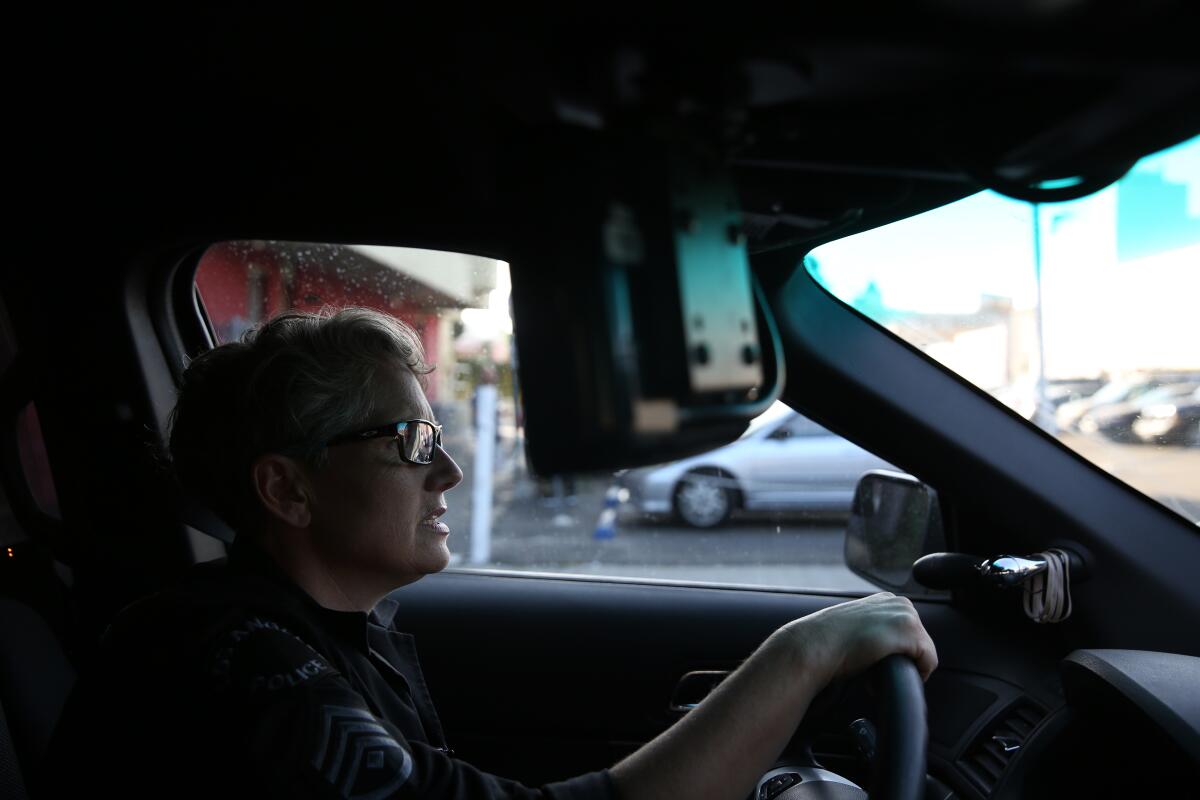
L.A.’s daily choreography — tents going up, tents coming down — serves residents who otherwise can’t walk along the sidewalks in their neighborhoods. But enforcing the law seems like one more expensive city effort that doesn’t fundamentally change anything.
She’s frustrated by the ritual, Geaney said, and she finds it ridiculous that it’s legal to sleep on sidewalks, which seems such a symbol of failure and surrender. But still, she thinks there’s good reason to enforce municipal codes.
“I care about these people,” she said, but no one in a tent is safe, and there’s no dignity. They use bottles for number one and buckets for number two, Geaney said. You see the buckets everywhere in Hollywood.
“I treat them with respect, but I have to enforce rules and regulations,” Geaney said.
And she doesn’t do it simply to placate neighbors or to harass homeless people, she told me.
“I do it because there has to be some semblance of order.”
Nothing pains her more than knowing that some service providers — and some homeless people — see the police effort as punitive and uncaring, said Geaney.
But she has her admirers, too.
“She’s a genius,” said Quigley, the First Presbyterian outreach director. She once called Geaney to handle an emergency involving a client who was having a breakdown and refusing to sign the paperwork that would keep him housed and safe.
“He was so symptomatic, he was climbing the side of the building,” Quigley said. “Shannon came and it was like Starsky and Hutch and she’s like, ‘Hey, how are you doing, John…. I’ve heard such great things about you.”
People experiencing psychotic breaks can be inclined to fear police rather than see them as allies, Quigley said. But Geaney had a way with this particular guy.
“She said, ‘You know, I have this job helping people who are experiencing homelessness and I hear you’re such a great tenant, I wouldn’t want anything to happen to you. Could you do me a favor and sign your paperwork?’ She just did it.... She’s a rock star.”
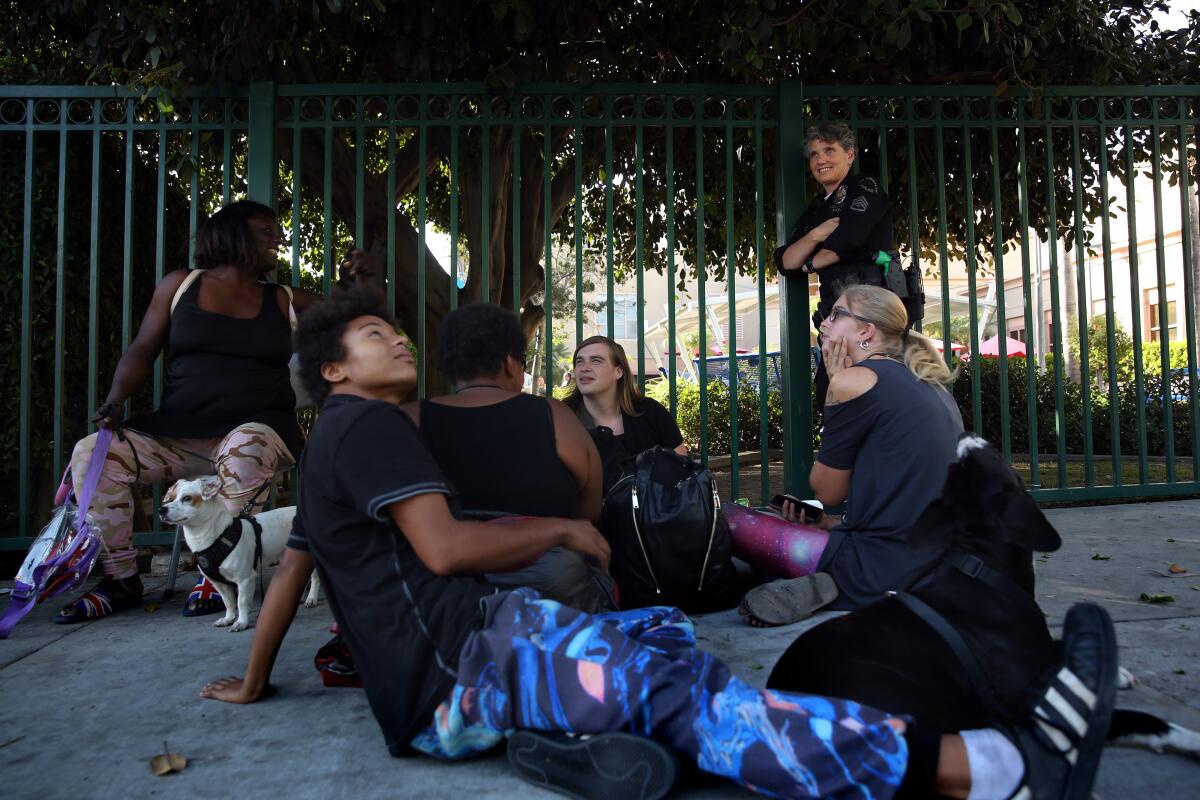
One day outside the shelter on Schrader, between Selma and Sunset avenues, Geaney was on her way to check in on Alicia, Tea, Gray and Keni — the crew that used to live on Carlos Avenue before being placed in temporary housing. But first she was flagged by a woman who announced that she would be getting permanent housing soon.
Geaney congratulated her but told the woman that wouldn’t be the end of the challenge. She had to keep working on rebuilding her life, Geaney told her, because housing doesn’t solve everything.
Geaney saved some of the tough love for Alicia and company, who were passing a joint.
“Just stop,” Geaney commanded, holding her hands over her head.
It’s just marijuana, they protested.
“Medically or not, you cannot smoke it in public,” Geaney told them, ordering them to put it out.
The crew updated Geaney on their status on housing lists, and she repeated her earlier advice.
“You can’t just be in housing, you’ve gotta have a plan,” Geaney said.
And a job.
Alicia said she already has a job. She works for her mother, who sends her accounting chores from Michigan. Alicia turns the work around and her mother sends her as much as $2,000 to $3,000 a month.
Geaney did the math and said if Alicia was making that kind of money, she should have been working to get an apartment on her own, without assistance.
But she only had about $1,500 left, Alicia said.
Geaney asked what happened to the rest of the money.
She spent a lot of it on marijuana, Alicia said, and a lot of it on Lyft, because she refuses to use public transportation or walk.
Geaney bristled. You’re homeless, she told Alicia, and you’re afraid to use public transit?
Alicia said she’d like to get a new job once she has housing. She’d like to be an assistant manager at a KFC.
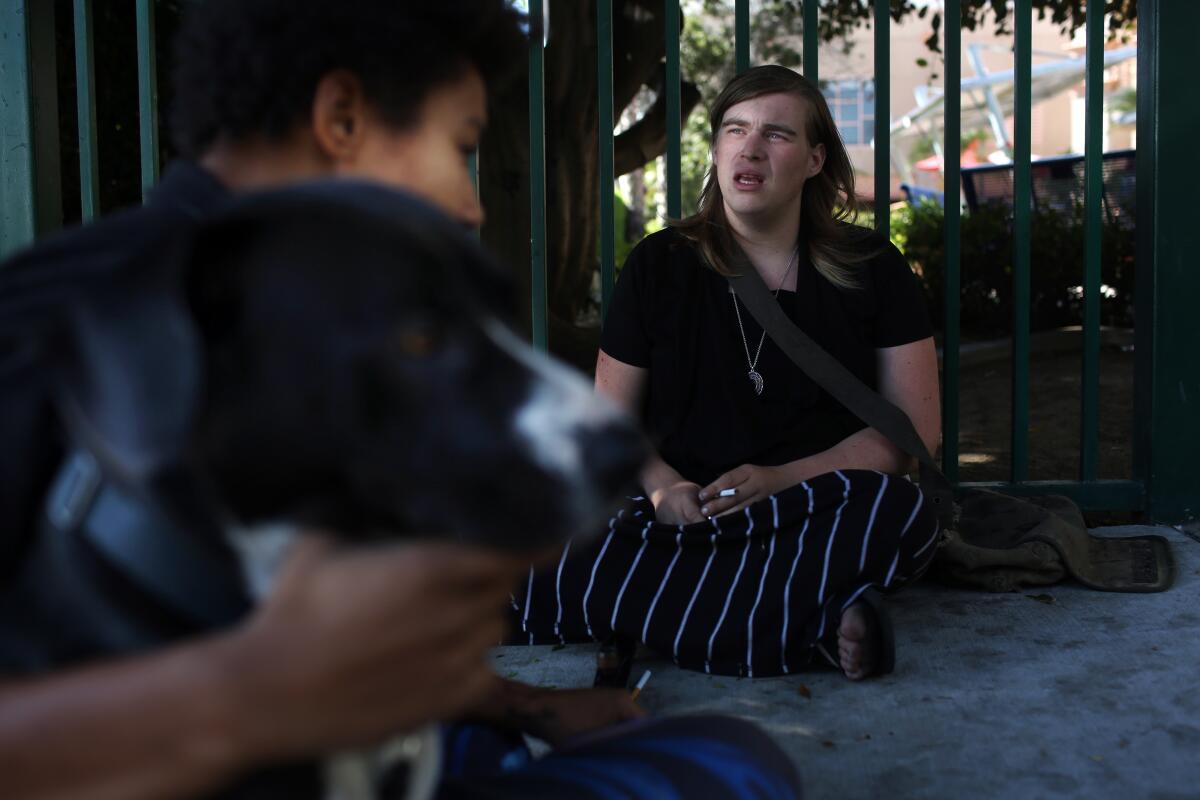
That night after work, Geaney went to a supermarket to do her shopping, and she noticed that the hard-working bagger had Down syndrome. It made her think, she said, about the young people she encounters every day in Hollywood.
Geaney knows better than anyone that a lot of homeless people have been hit with all manner of damage and disability, but she wished she had pushed back harder in the conversation with Alicia. The supermarket bagger had challenges, too, but was working and making a contribution. Geaney wished she’d encouraged Alicia to get more proactive about escaping the life she’s living.
I guess it’s the Marine training that keeps Geaney marching, even on days when it seems the battle is being lost. It has not escaped her attention that a homeless shelter opened in the heart of Hollywood, and all around, encampments seem to be getting bigger. Geaney said that happened when police were told to ease off a bit, so outreach workers could connect with homeless clients rather than have to chase them around.
It’s hard enough to be a cop out there without adding social work and homeless policy mapping to the workload, but Geaney can’t let things go. She’s bothered by what she sees, and she believes there have to be better ways to help homeless people and the community at the same time.
Geaney said she’s seen people “who have all their faculties” get Section 8 housing vouchers, but she’s had to hound the Los Angeles Homeless Services Authority to try to get severely disabled people off the streets.
If you’re in a shelter and the goal is to get you self-sufficient, Geaney said, and you’re not severely disabled, why can’t you be required to do some chores and learn some job skills? Are you really getting either the support or the push you need if you can sleep late, hang with friends and step outside the shelter whenever you want to get high?
Geaney and her team of officers estimate that 90% of the homeless people with whom they have contact in Hollywood are addicted to something, and it’s going to be hard for those people to make it even if they get housing. But even for someone who overdoses, Geaney said, it can be hard for her to link them to the help they need.
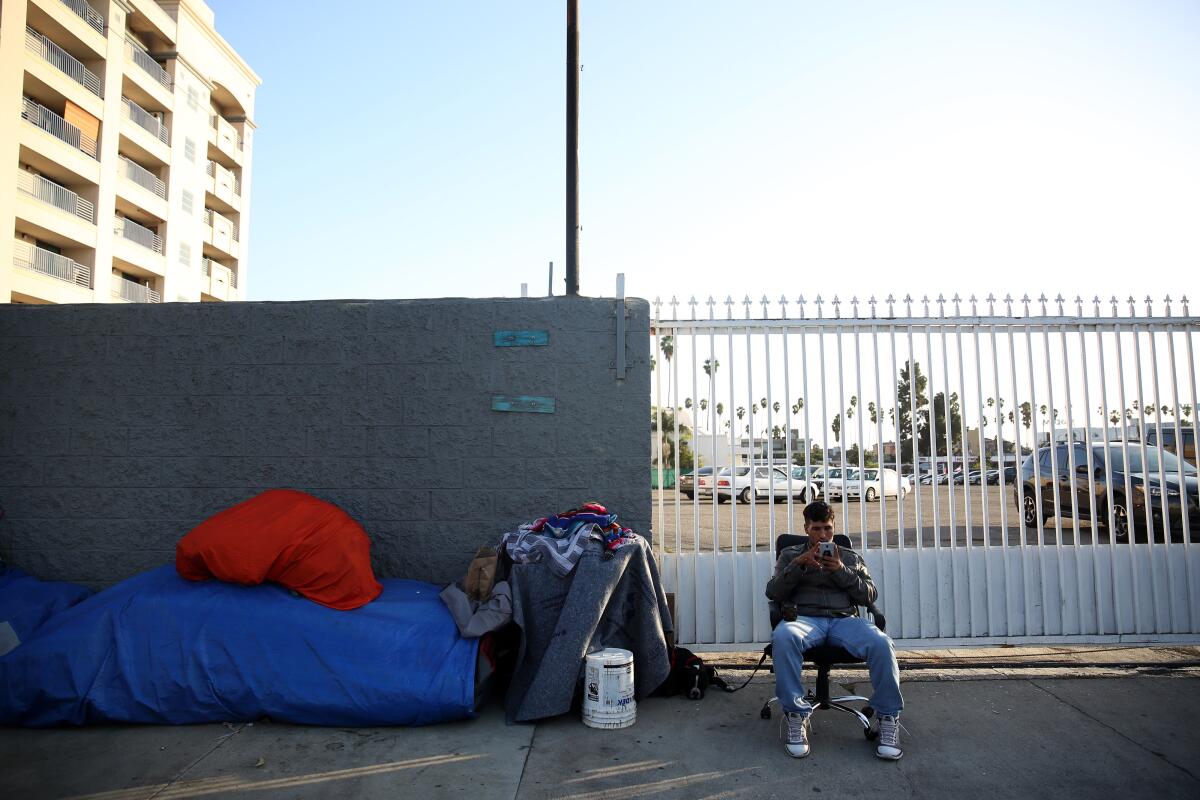
If we’ve got an epidemic on our hands, why isn’t there a drop-everything, all-out, full-scale, inpatient, outpatient response, with battalions lining up and delivering intervention, counseling and rehab?
Geaney respects the chain of command and isn’t one to step out of line. But I could see her going with her gut one of these days — or maybe it was wishful thinking on my part — and taking to the street with a bullhorn and a call to action — this is an emergency, people, so let’s act like it.
Lord knows we need that from someone, and Geaney has the spine of a cop and the heart of a social worker.
When she tours encampments, she told me, she’s always on the lookout for those who seem ready for something different.
“If they want a better life, I ask what they’re willing to do to get it. If they say if only they had a job, I tell them I’ll help, and here’s what we’re going to do: ‘Meet me tomorrow at x o’clock at Chipotle,’” Geaney said.
If they show up — and she’s had a few takers — Geaney never hooks them up to all the services they want on the first day. They’ve got to show her they’re serious, so maybe there will be another lunch date. If they keep passing tests, she’ll connect them to someone at the authority, or let them use her name on a job application, or offer to pay for shoes or clothing or a uniform.
“They’re refugees from the American dream,” Geaney said.
“The reality of it for me is that if I was a mid-level career supervisor in the early ’90s, I would have been all in on gangs and drugs because that was the most pressing issue for public safety at that time,” Geaney told me. “I truly believe that the greatest threat to our public safety and streets, and all our lives, is the fact that so many of our neighbors are unsheltered.”
More to Read
Sign up for Essential California
The most important California stories and recommendations in your inbox every morning.
You may occasionally receive promotional content from the Los Angeles Times.




